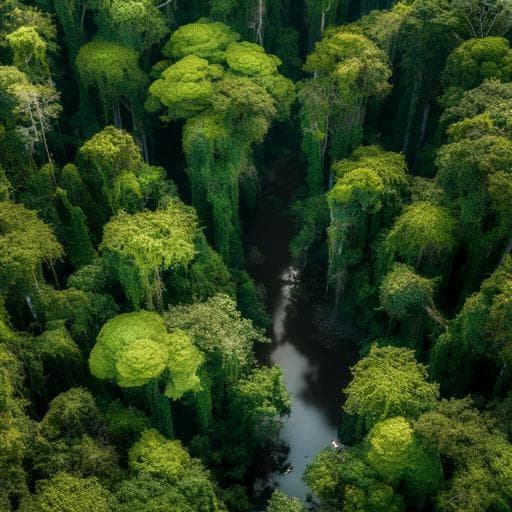
Environmental Studies and Forestry
Amazon forests capture high levels of atmospheric mercury pollution from artisanal gold mining
J. R. Gerson, N. Szponar, et al.
This study reveals alarming levels of mercury emissions from artisanal and small-scale gold mining in the Peruvian Amazon, showcasing how intact forest canopies capture significant amounts of mercury, affecting the atmosphere, soil, and local wildlife. The research by a team of experts underscores urgent conservation concerns in these fragile ecosystems.
~3 min • Beginner • English
Introduction
Artisanal and small-scale gold mining (ASGM) occurs in over 70 countries, provides livelihoods, but causes deforestation, river sediment loading, and is now the largest global source of atmospheric and freshwater mercury emissions. While policy efforts under the Minamata Convention aim to reduce Hg releases from ASGM, most research has focused on aquatic exposure pathways and human occupational or dietary exposure. Terrestrial pathways of Hg deposition include oxidation of gaseous elemental mercury (GEM) to Hg(II) and wet deposition, sorption of GEM to particles intercepted by canopies (throughfall), and direct foliar uptake followed by litterfall. The extent and relative importance of these pathways near intense ASGM in tropical forests are poorly quantified, and canopy structure may strongly influence deposition. This study addresses: (1) how GEM concentrations and depositional pathways vary with proximity to ASGM and with canopy leaf area index; (2) whether soil Hg storage is related to atmospheric inputs; and (3) whether Hg bioaccumulation is elevated in resident forest songbirds near ASGM. The work provides the first measurements of methylmercury (MeHg) in terrestrial landscapes of the Peruvian Amazon near ASGM.
Literature Review
Prior studies show ASGM emits an estimated 675–1000 tons Hg per year, shifting major emission sources to the Global South. Research has documented Hg enrichment adjacent to ASGM and focused on aquatic bioaccumulation, inhalation exposure, and fish consumption risk. Forest canopies at higher latitudes enhance dry deposition via throughfall and litterfall, and foliage can assimilate GEM, but tropical forest canopy effects near intense ASGM emissions remain underexplored. Background GEM in the Southern Hemisphere is ~1 ng m−3; elevated levels have been associated with industrial and urban sources elsewhere. Wet deposition and dry deposition processes, and their modulation by canopy characteristics such as leaf area index, leaf age, and microclimate, have been characterized in boreal/temperate systems but lack quantification in tropical ASGM regions.
Methodology
Study area and design: Five sites were established along a ~200 km reach of the Madre de Dios River, southeastern Peruvian Amazon: two remote sites without mining (Boca Manu ~100 km from ASGM; Chilive ~50 km from ASGM) and three within the mining zone (Los Amigos Conservation Concession—intact old-growth; Boca Colorado; Laberinto—secondary growth near mining towns). At each site, deposition samplers were installed in paired microhabitats: deforested clearings (void of woody plants) and beneath forest canopies. Sampling occurred over three seasonal campaigns: 2018 dry season (July–August), 2018 wet season (December–January), and 2019 dry season (July–August). In year two, six additional forest plots were added at Los Amigos to expand canopy density coverage.
Atmospheric GEM: Passive air samplers (PAS; McLagan et al. design) were deployed in clearings to collect GEM by diffusion through a Radiello barrier onto sulfur-impregnated activated carbon. One PAS per site in 2018 dry season; duplicate PAS in wet season. GEM concentrations were calculated from blank-corrected Hg mass, deployment time, and temperature/wind-adjusted sampling rates (0.135 m3 day−1), with QC via standards and blanks.
Deposition sampling: Bulk precipitation collectors in clearings and throughfall collectors under canopies (glass funnel to PETG bottle) were installed (typically three collectors per microhabitat per site; some losses due to flooding/interference). Precipitation was sampled for ~4 weeks (dry season) and 2–3 weeks (wet season). Litterfall baskets collected bulk litter; live canopy leaves of Ficus insipida and Inga feuillei were sampled (n≈3 per site). Soils were collected from 0–5 cm (surficial) and profiles to 45 cm at select sites.
Laboratory analyses:
- Total Hg in PAS sorbent: thermal desorption and AAS (EPA 7473) on Hydra C, with NIST standards; blanks were below detection; data blank-corrected.
- Total Hg in waters: BrCl oxidation, SnCl2 reduction, purge and trap, CVAFS (EPA 1631E; Tekran 2600); DL 0.02–0.5 ng L−1 depending on season; standards within 15% recovery.
- Total Hg in leaves and soils: DMA-80 (EPA 7473); calibrations with NIST/CRM materials; duplicates within 10% RPD; DL 0.2–0.5 ng. Results reported on dry mass.
- MeHg: Waters (acid extraction), leaves (KOH/methanol digestion), soils (microwave HNO3 digestion). 2018 dry: ethylation, purge and trap, CVAFS (EPA 1630); 2019 dry: ethylation, purge and trap, GC, ICP-MS; standards within 15% recovery; blanks BDL.
- Bird feathers: Total Hg by DMA-80 (EPA 7473) at Biodiversity Research Institute; DL 0.001 µg g−1; fresh weight basis.
Other chemistry: Anions/cations via ion chromatography (EPA 4110B) and trace elements by ICP-MS.
Canopy structure: Leaf Area Index (LAI) quantified at Los Amigos using UAV-LiDAR (GatorEye) workflows to compute leaf area density and LAI at 1 m resolution; LAI extracted at plot GPS points.
Flux and pool calculations: Annual Hg fluxes in forests estimated as throughfall + litterfall; in deforested areas from bulk precipitation. Annual rainfall at Los Amigos averaged ~2500 mm yr−1 (2009–2018). Flux estimates used the average of dry (2018, 2019) and wet (2018) season concentrations. Litterfall Hg flux estimated using literature litterfall mass (417 g m−2 yr−1) for Peruvian Amazon and measured litter Hg concentrations. Soil pools (0–5 cm) used measured Hg concentrations and assumed bulk density 1.25 g cm−3. Statistical analyses used R 3.6.1: OLS regressions, Kruskal-Wallis and pairwise Wilcoxon tests (alpha 0.05).
Key Findings
- Atmospheric GEM: Remote sites were below the Southern Hemisphere background (~1 ng m−3), while mining-zone sites were 2–14× higher; sites near amalgam-burning towns reached up to 10.9 ng m−3, comparable to industrial/urban regions.
- Throughfall and canopy effects: Throughfall total Hg was highest in intact old-growth forest within the mining zone (Los Amigos), with dry-season throughfall concentrations 18–61 ng L−1—among the highest reported globally for comparable precipitation volumes. Annual throughfall flux at Los Amigos was estimated at 71 µg m−2 yr−1.
- Litterfall: Live canopy leaves at mining sites contained 0.080–0.22 µg g−1 total Hg, exceeding many values from temperate/boreal/alpine forests and other Amazonian sites; bulk litter Hg was highest in secondary forests near mining. Estimated litterfall Hg flux at Los Amigos was 66 µg m−2 yr−1.
- Total atmospheric Hg loading: Preliminary total atmospheric Hg flux (throughfall + litterfall + precipitation) to forested conservation areas adjacent to ASGM was ~137 µg m−2 yr−1 versus ~9 µg m−2 yr−1 in adjacent deforested areas—over 15× higher in forests. Approximately 94% of total Hg deposition in forests occurred via dry deposition (throughfall + litterfall), indicating canopy-dominated scavenging of ASGM-derived Hg.
- Bulk precipitation: Total Hg in precipitation during the dry season was 1.5–9.1 ng L−1 across sites and generally low; bulk deposition fluxes in deforested areas were 8.6–21.5 µg m−2 yr−1 and did not reflect proximity to mining.
- Seasonality: Hg fluxes and between-site differences were pronounced in the dry season and minimal in the wet season, likely reflecting increased mining intensity and dust generation during dry periods.
- Canopy structure: Leaf area index (LAI) strongly predicted throughfall Hg concentration at Los Amigos (R2 = 0.68, p = 0.0075), indicating Hg deposition scales with canopy leaf area.
- Soils: Surficial soils (0–5 cm) at Los Amigos forest had the highest total Hg (~140 ng g−1 in 2018 dry season) and were enriched down to 45 cm (138–155 ng g−1). A deforested site near Boca Colorado showed very high surficial Hg, likely from local elemental Hg contamination; deeper soils were not elevated. Estimated soil Hg pools at Los Amigos: ~9100 µg m−2 (0–5 cm) and >80,000 µg m−2 (0–45 cm). Forest soils likely retain more Hg due to reduced evasion under canopy cover. Surficial soil Hg correlated with throughfall Hg in forests, but not with bulk precipitation in deforested areas.
- Methylmercury (MeHg): Measurable MeHg occurred in upland Amazonian soils near ASGM for the first time reported, with highest surficial concentrations at Boca Colorado and Los Amigos (1.4 ng g−1 [1.4% of total Hg] and 1.1 ng g−1 [0.79%], respectively). Percent MeHg was comparable to other terrestrial sites, implying high MeHg concentrations arise from high total Hg inputs and storage rather than unusually high methylation efficiency.
- Biota: Tail feather total Hg in resident songbirds was elevated at the mining-impacted Los Amigos versus remote Cocha Cashu across trophic guilds: Myrmotherula axillaris 1.8 µg g−1 (n=10) vs 0.9 (n=2); Phlegopsis nigromaculata 4.1 (n=10) vs 1.4 (n=2); Pipra fasciicauda 0.3 (n=46) vs 0.1 (n=2). At Los Amigos, Phlegopsis individuals exceeded effect thresholds: 3 above EC10, 3 above EC20, and 1 above EC30; no exceedances at Cocha Cashu.
Discussion
Findings demonstrate that proximity to ASGM elevates atmospheric GEM, but deposition to land is primarily controlled by forest canopy structure. Intact tropical canopies near ASGM effectively scavenge both particulate and gaseous Hg, leading to exceptionally high dry deposition via throughfall and litterfall, with deposition rates increasing with leaf area index. These elevated inputs translate into large Hg pools in soils, with detectable MeHg present even in upland soils, indicating potential for Hg entry into terrestrial food webs. Elevated Hg in resident songbirds across trophic guilds at the impacted site suggests that deposited Hg is bioavailable and bioaccumulating, with some individuals reaching levels associated with reduced reproductive success. While forests may buffer aquatic systems and the global atmosphere by sequestering Hg, their capacity is insufficient to capture all ASGM emissions, and stored Hg is vulnerable to remobilization via deforestation, fires, evasion, and runoff. Thus, the risk from ASGM-derived Hg is a combined function of emission intensity and landscape canopy structure, with old-growth forests—despite their conservation value—becoming hotspots for Hg deposition and storage adjacent to ASGM.
Conclusion
This study provides the first comprehensive assessment of Hg deposition pathways near ASGM in the tropical Amazon and the first measurements of MeHg in terrestrial soils in this context. It shows that intact forest canopies intercept large amounts of atmospheric Hg at rates proportional to leaf area, resulting in globally high throughfall and substantial litterfall Hg fluxes. Forested areas near ASGM receive over an order of magnitude greater atmospheric Hg loading than adjacent deforested areas, leading to large soil Hg pools and measurable MeHg, and elevated Hg in resident songbirds. Management implications include the need to prevent ASGM within and near protected areas and buffer zones, reduce Hg releases (e.g., retorts, formalization of ASGM), and consider how land-use change could mobilize legacy Hg. Future research should quantify Hg bioaccumulation and health effects across terrestrial taxa, assess MeHg dynamics in seasonal/permanent wetlands, refine spatial deposition gradients with higher-resolution canopy metrics, and evaluate mitigation strategies’ effectiveness in reducing terrestrial Hg loading.
Limitations
- Spatial and temporal coverage: Five sites along a single river reach with three seasonal campaigns; wet-season contrasts were limited, and some samples were lost due to flooding or interference.
- GEM sampling density: One PAS per site in the 2018 dry season and duplicate in the wet season provide limited replication for atmospheric concentrations.
- Flux upscaling: Annual fluxes were estimated by combining short-term seasonal concentrations with long-term rainfall, literature-based litterfall mass, and assumed soil bulk density, introducing uncertainty.
- MeHg measurements were only collected in the 2018 dry season, limiting seasonal inference for methylation.
- ASGM emission source locations and intensities were not precisely mapped due to clandestine activities, adding uncertainty to proximity analyses.
- The deforested area at Los Amigos represents a station clearing, which may not fully represent all deforested mining landscapes.
Related Publications
Explore these studies to deepen your understanding of the subject.







